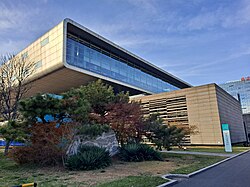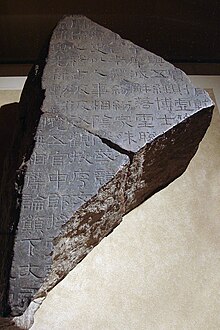
Hebei is a province in North China. Hebei is China's sixth most-populous province, with over 75 million people. Shijiazhuang is the capital city. The province is 96% Han Chinese, 3% Manchu, 0.8% Hui, and 0.3% Mongol. Varieties of Chinese spoken include Jilu Mandarin, the Beijing dialect of Mandarin, and Jin Chinese.
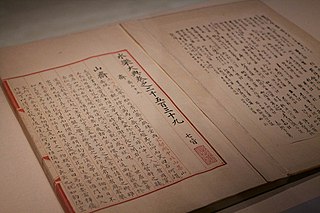
The Yongle Encyclopedia or Yongle Dadian Chinese leishu encyclopedia commissioned by the Yongle Emperor of the Ming dynasty in 1403 and completed by 1408. It comprised 22,937 manuscript rolls in 11,095 volumes. Fewer than 400 volumes survive today, comprising about 800 rolls, or 3.5% of the original work.
The China Academy of Art is a provincial public college of fine arts in Hangzhou. Zhejiang, China. It is affiliated with the Province of Zhejiang. The academy is part of the Double First-Class Construction.
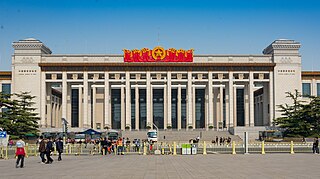
The National Museum of China is the national museum of China. It flanks the eastern side of Tiananmen Square in Beijing, China. The National Museum of China has a total construction area of about 200,000 square meters, a collection of more than 1.4 million items, and 48 exhibition halls. It is the museum with the largest single building area in the world and the museum with the richest collection of Chinese cultural relics. It is a level-1 public welfare institution funded by the Ministry of Culture and Tourism.

Luntai County, also known as Bugur County or Bügür County, is a county in central Xinjiang Uyghur Autonomous Region under the administration of the Bayin'gholin Mongol Autonomous Prefecture. It contains an area of 14,189 km2 (5,478 sq mi). According to the 2002 census, it has a population of 90,000.
The first libraries in China came into being during the time of the Shang dynasty as intellectuals known as the Shi (historians) and Wu (diviners) emerged from manual labor to special occupations for the creation and spread of culture. Among the documents that these occupations managed were "the country's statute books, genealogies of imperial kinsmen, issued notices and orders, and recorded important events and natural phenomena. For future verification and reference, they built storehouses to keep records in different media. To meet the needs of more and more complicated affairs and to ensure easy use, they began to collect and sort out those records according to chronological order and category. Thus, the earliest library in China came into being. The numerous kinds of media loaded with information and knowledge emerged in human society, resulting in the concepts of preservation and collection. Accordingly, the earliest libraries and archives were the result of conscious collection, process, coalition, and utilization."

Nanjing Library is the third-largest library in China with over 10 million items. It houses important scientific, cultural and arts literature relating to Jiangsu province and other national historical records such as ancient Chinese and foreign publications. As located in the ancient capital Nanjing, the library contains 1.6 million ancient books and 100,000 volumes of books, documents and manuscripts dating from the Tang dynasty to the Ming dynasty.

Zhejiang University Library is the libraries system of Zhejiang University, and one of the largest and oldest university libraries in China.
Deng Wei Hon FRPS was a Chinese portrait photographer who was a professor at Tsinghua University, China. He was known for his photographic projects such as the Chinese Cultural Celebrity Portrait project, and the World Celebrities project.
Chiang Fu-tsung, courtesy name Weitang, was a Chinese educator and politician of the Republic of China.
Yanguangshi, was the first Chinese publishing house to publish Photobooks of famous ancient painting and calligraphy from the imperial collections using the colophon photographic printing technique.
The Peking Field Force was a modern-armed military unit that defended the Chinese imperial capital Beijing in the last decades of the Qing dynasty (1644–1912).
The Yangshi Lei Archives are the collection of design drawings and models of Qing imperial architecture. "Yangshi" means architect or architecture, "Lei" is the surname of the Lei architectural family.
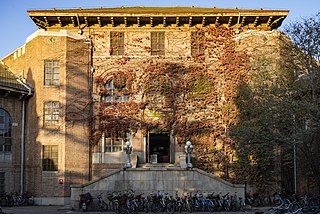
Tsinghua University Library System consist of the Main Library and six branch libraries: Humanities & Social Sciences Library, Economics & Management Library, Law Library, Architecture Library, Fine Arts Library, and Finance Library. The Main Library, with a total construction area of 42,820 square meters, consists of the Old Library, West Library and North Library. The West and North Libraries are integrated harmoniously in style with the Old Library.
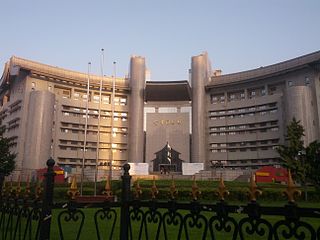
The Capital Library, also known as the Capital Library of China, shortened as CLCN, is the largest public library in Beijing, located in Chaoyang District. The library is noted for its collection of Chinese opera, classical music, drama and theater.
Miao Quansun, courtesy name Yanzhi, was a Chinese philologist, historian, educationalist, bibliographer and librarian. He oversaw the foundation of the Jiangnan Library in Nanjing and was the first administrator of the National Library of China in Beijing.

Ningbo Library is a public library located in Ningbo, Zhejiang Province, China. It is under the jurisdiction of the Ningbo Municipal People's Government, under the administration of the Ningbo Municipal Bureau of Culture, Radio, Television, and Tourism, and is a legal entity established by the Ningbo Municipal Government as a public welfare institution. As the center of Ningbo's public library service system, Ningbo Library not only has paper and electronic books, journals, and newspapers but also has a wide range of collections such as handwritten books, calligraphy, picture albums, photos, music, film, and television materials. Among them, the library has collected the writings of famous Ningbo people as well as Ningbo local newspapers and magazines in the work of preserving in situ cultural relics, which is the characteristic collection of the library. Based on the above-mentioned collection, the library has conducted research on literature resources in Ningbo and surrounding areas. By the end of 2020, the library had a collection of 3.1 million paper books, over 3.6 million electronic books, and 15000 electronic journals.

The Taizhou City Library, also known as Taizhou Library (台州图书馆), abbreviated as Tai Tu (台图), is a municipal-level public library located in Taizhou, Zhejiang, People's Republic of China. It is supervised by the Taizhou Municipal Bureau of Culture, Radio, Television, Tourism, and Sports, and is an affiliated unit of the latter. The library building is situated at 168 Hexie Road, Jiaojiang (Taizhou). As of 2019, the total collection of documents in the library reached 876,774 volumes, making it a nationally recognized first-grade library evaluated by the Ministry of Culture and Tourism.
Xianju County Library, also known as Xianju Library (仙居图书馆), is a county-level public library located in Xianju, Taizhou, Zhejiang Province, People's Republic of China. It is under the jurisdiction of the Xianju County People's Government and is supervised by the Bureau of Culture, Radio, Television, Tourism, and Sports of Xianju County. The library building is located at No. 2 Jiefang Street in Xianju County and includes several branches and academies in various forms. As of July 2018, the collection of Xianju County Library reached 811,314 volumes. In 2018, it was promoted to a national first-grade library.
